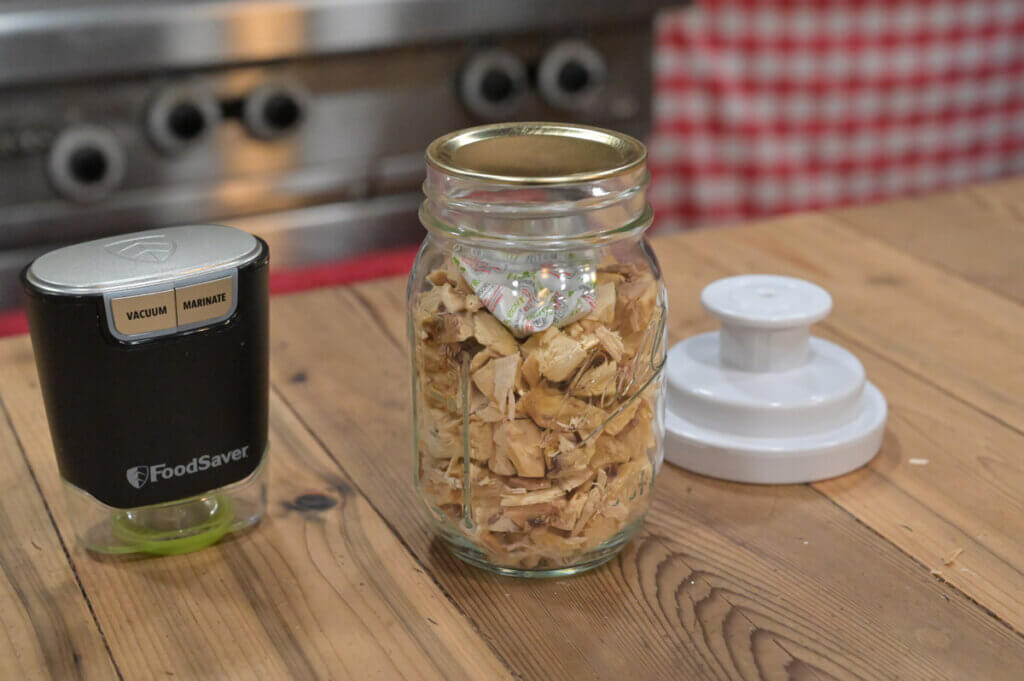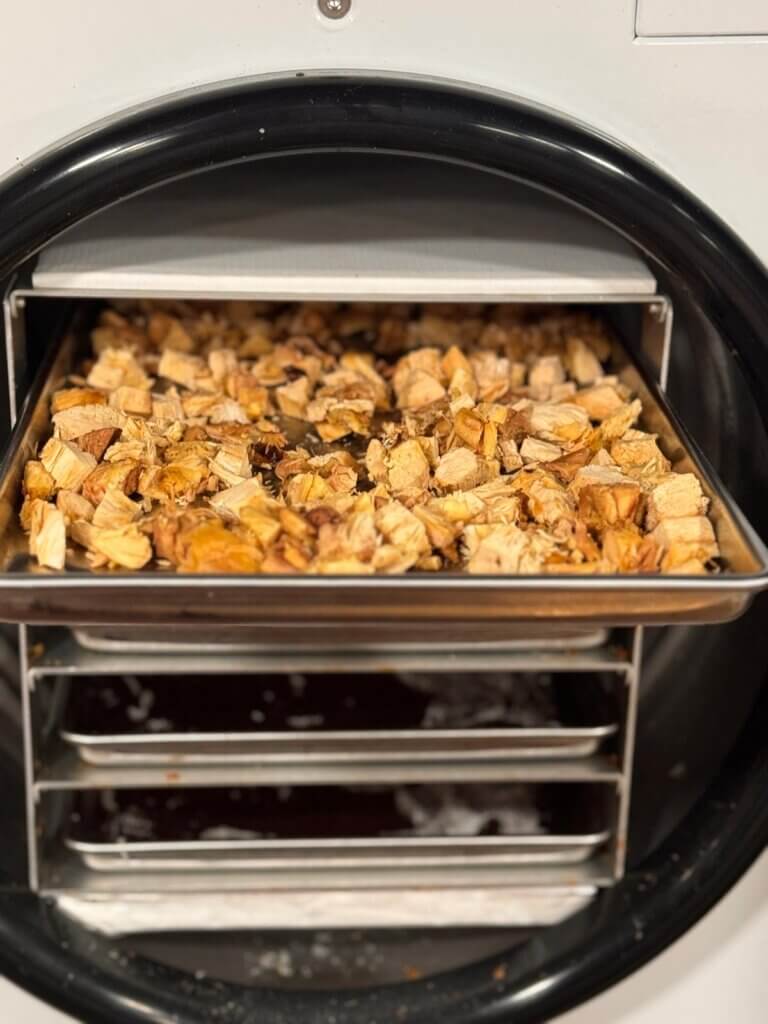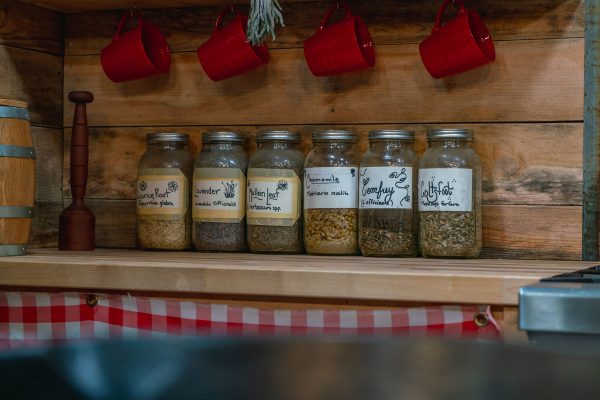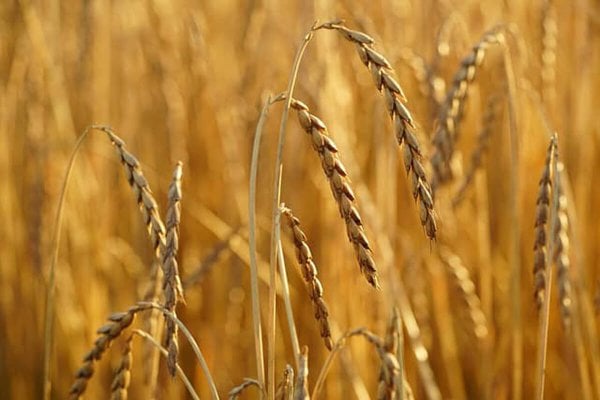Freeze dried meat is not a preservation method our ancestors used, but with today’s technologies, we can use this convenient source to preserve all kinds of meat.

It’s a common misconception that freeze dried meat is just an emergency survival food to bulk up your long-term food storage, but keep reading to learn the best way to freeze dry meat and how it can save you time and money.
Why I Love Freeze Dried Meat
In the past, I have shared a pantry tour to inspire you to increase self-sufficiency and save money at the grocery store. A critical element to success is using various food preservation methods always to have a year’s worth of food on hand.
When it comes to meat, we freeze most of what we butcher. In a short-term power outage, we can keep our freezers running with a generator, but it’s not practical to open them during this time to pull out something to cook.
Canning beef (or venison) and canning chicken have proven to be a great solution for power outages or for busy nights when it would otherwise be tempting to grab convenience food.
Adding a Harvest Right freeze dryer provided another method to prepare for emergencies and avoid the costly pitfalls of purchasing unhealthy processed foods.
It allows us to make complete meals like freeze dried chicken pot pie and prepare foods like freeze dried potatoes, freeze dried corn, freeze dried eggs, or freeze dried meat to choose later how they will be used in a recipe.

Best Meats to Freeze Dry
It’s important to note some foods cannot be freeze dried, and fatty meats are one of them. All meat should have excess fat trimmed and bones removed before freeze drying.
On our homestead, we are fortunate to raise a year’s worth of meat with Red Ranger meat chickens, Kune Kune Pigs, and cattle. If you are considering raising your own meat, we recommend learning what you need to know BEFORE butchering day and these tips for butchering meat.
If raising farm animals isn’t feasible, we recommend finding a local and trusted source. Learn how to decode meat labels at the store or ask to visit the farming operation to make sure the animals are raised and butchered in a manner that provides a healthy harvest.
Is It Better to Freeze Dry Raw or Cooked Meat
You can freeze dry either raw or cooked meat, but it’s important to understand that although freeze drying meat allows you to store your meat at room temperature, it still contains the same harmful bacteria as raw meat.
The freeze drying process uses frigid temperatures between -30°F and -50°F, not killing off bacteria but simply hibernating them. So, if you choose to freeze dry raw meat, it is critical to make sure your meat is fully freeze dried before storing. Then, make sure to use proper handling methods when reconstituting it and cooking it. Homesteading Hack: Freeze dried raw meat is still raw once reconstituted and must be cooked.

Supplies Needed
- Freeze Dryer – I recommend the Harvest Right Freeze Dryer. It comes in four sizes, making it versatile for your particular needs.
- Parchment Paper – To prevent the meat from sticking to the freeze drier trays, we prefer natural products to petroleum-based wax paper and recommend If You Care Parchment found at Azure Standard. Homesteading Hack: If you’re a first-time Azure Standard customer, use coupon code “HOMESTEADINGFAMILY15” at checkout for 15% off your order of $100 or more!
- Knives – Sharp, clean knives to cut, chop and slice meats to the proper thickness is essential.
- Cutting Board – A clean meat-specific cutting board for preparing the meat is a good safety precaution.
- Cooking Source – If pre-cooking your meat before freeze drying, you will need a stove, oven, Instant Pot, BBQ or Crock Pot to ensure it’s thoroughly cooked.
- Meat Thermometer – Using a meat thermometer to make sure meats are cooked to a safe and recommended temperature is a good safety measure before freeze drying.
- Mason Jars or Mylar Bags – Storing freeze dried food with an airtight seal is a must. We use Mason jars for most of our storage because they’re reusable. When we use Mylar bags (great for camping/backpacking trips), we purchase them from Azure Standard. Keep in mind you will need a vacuum sealer if using the bags.
- Oxygen Absorbers – Oxygen is the enemy of freeze dried food. Using an oxygen absorber gives extra insurance to your airtight seal. We buy our oxygen absorbers from Azure Standard.
- Jar Sealer – If storing in Mason jars is the best approach for you, I recommend using this jar sealer to ensure an air-tight seal. Homesteading Hack: Promptly re-seal the jar after every use.

Ingredients Needed
Whatever meat you freeze dry, prepare it according to its specific needs.
Slice or dice the meats for best results and quick rehydration. If the cut is too thick (anything over an inch), it will not freeze dry thoroughly, will become hard as a rock and could be unsafe to eat when prepared.
Bring all pre-cooked meats to a safe temperature, and then proceed with preparation.
- Beef and Game Meats – Most cuts of beef and game meats freeze dry well with little preparation. Trim unwanted fats and remove the bones; they don’t freeze dry well due to their density. Homesteading Hack: Ground beef made into smaller patties not more than ½” thick will rehydrate quicker than if you keep it in large, thick, pound-size pieces.
- Chicken – Trim fat and remove skin and meat from bones. Refer to my full guide on freeze drying chicken for more specific instructions. Homesteading Hack: Use your chicken scraps to make this immune-boosting bone broth.
- Pork – Trim fat and remove meat from the bones. Homesteading Hack: If you are removing leaf-lard or fatback, don’t throw it away! Learn how to render lard, and use it as a natural and healthy fat in your homestead cooking.
- Fish – Pre-cook the fish and remove the bones from the meat before freeze drying; leaving the head, skin and tail on is optional.
- Seasonings – If you want to brine or season any of the meats, do so before cooking or, if raw, season after you reconstitute the meat before cooking or adding to your favorite dish.


How to Freeze Dry Meat Step by Step
- Cover the trays with parchment paper or non-stick mats and set aside.
- Prepare the meat of choice on a clean cutting board with a clean, sharp knife by removing it from the bones and trimming any unwanted fat.
- The meat should not be more than an inch thick for best results. If thicker, it will become brick-hard and be challenging to deal with.
- Turn on the freeze dryer to the recommended setting.
- Place the meat on the tray with a small space between each piece; don’t overcrowd the tray.
- Place the trays into the freeze dryer and set a timer for the recommended amount of time for each type of meat. One of the features of Harvest Right Freeze dryer is a sensor that beeps, letting you know when the food is thoroughly freeze dried.

Frequently Asked Questions
How to Tell If the Meat Is Done
The meat should not be cold to the touch when properly freeze dried. Break a piece in half; if moisture is still in the meat, or it feels cold to the touch, return it to the freeze dryer for two more hours and check again.
How to Store Freeze Dried Meat
When properly freeze dried and sealed, you can store freeze dried meat at room temperature (below 72°F). For best results, keep away from light and humidity. If you do not use the entire contents after opening, always reseal your storage container using a vacuum sealer.
How to Rehydrate Freeze Dried Meat
The most accurate way to know how much liquid is needed to rehydrate any freeze dried food is to weigh it before and after freeze drying. Keep notes and add the difference between the two weights when rehydrating.
However, freeze dried meat will only absorb the water it needs, so if you use too much, you can just remove it from the water and pat it dry with a paper towel.
If the meat was cooked before freeze drying, you just need to reconstitute it in a bowl of hot water (or broth for added flavor) and serve. If the meat is raw, place it in a bowl of cold water in the refrigerator until reconstituted and then handle it like any other raw meat.
Homesteading Hack: If you plan to marinate your meat, use the marinade to reconstitute your freeze dried meat to save time and add more flavor. Broth can also be used instead of water.
Did you try freeze drying meat? If so, please leave a star rating in the recipe card below, then snap a photo of your freeze dried meat and tag us on social media @homesteadingfamily so we can see!

Freeze Drying the Harvest
While I love my freeze dryer for preserving our garden produce and healthy convenience meals, it has also become a workhorse for supporting our natural approach to healthcare.
In my book Freeze Drying the Harvest: Preserving Food the Modern Way, I’ll teach you how to preserve vitamin-packed super-smoothies for a hot summer day, freeze dry powerful medicinal herbs, and immunity-boosting fire cider bites to get you through cold and flu season.
There has been such a high demand for this tested and trusted information that I have also added a Freeze Drying Masterclass to my online video classes in the Abundant Pantry.
These resources can be purchased separately or as companions, so whether you choose the book or the masterclass, you will receive all the information you need to have a pantry packed full of healthy food year-round!


















